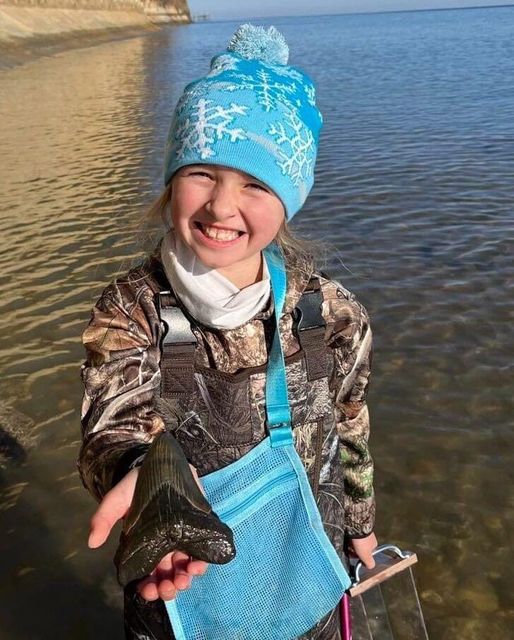A Beachcombing Adventure Turned Extraordinary
On Christmas Day in 2022, a nine-year-old girl named Molly Sampson experienced a day unlike any other. While many children were busy opening presents, Molly, armed with her new shark-tooth hunting waders, set out on an adventure that would leave a lasting mark on her memory. As she waded through the chilly waters of the Chesapeake Bay, she stumbled upon a find so rare and exciting that it instantly catapulted her into the world of paleontology: a massive Megalodon tooth.
The Thrill of the Hunt
Molly had been fascinated by shark teeth since she was a small child. Her family often spent time at Calvert Beach in Maryland, a hotspot for fossil hunters due to the abundance of ancient relics that wash ashore. This Christmas, her excitement was palpable as she donned her new waders and ventured into the water, shovel and sieve in hand.
The beachcombing pastime, while often yielding common finds like seashells and driftwood, can occasionally surprise even the most seasoned hunters. Fossil collecting, in particular, blends the thrill of discovery with a tangible connection to prehistoric history. On this day, Molly’s dedication and keen eye paid off in the most spectacular way.
Unearthing the Megalodon Tooth
Molly’s discovery was nothing short of miraculous. As she sifted through the sand and sediment, her hands brushed against something large and hard. She pulled it out, and there it was: a giant tooth from a Megalodon, a prehistoric shark that ruled the oceans millions of years ago.
The Megalodon, whose name means “big tooth,” lived from the Early Miocene to the Pliocene epochs, approximately 23 to 3.6 million years ago. These ancient predators were colossal, with teeth that could reach up to seven inches in length. Molly’s find, while not quite that large, was still an impressive specimen.
Sharing the Find
Rather than keeping her discovery to herself, Molly decided to share it with the world. She brought the Megalodon tooth to the Calvert Marine Museum, where experts could examine and authenticate it. The museum staff was thrilled, noting that while Megalodon teeth are occasionally found along the Calvert Cliffs, one of this size was particularly rare.
Stephen Godfrey, the museum’s curator of paleontology, confirmed that the tooth was approximately 15 million years old. He praised Molly’s dedication and enthusiasm, which had led to such an extraordinary find.
Community Engagement and Educational Impact
The museum’s reaction to Molly’s discovery was overwhelmingly positive. In a Facebook post, they celebrated her find and encouraged others to participate in their “First Fossil Friday” program, which helps budding fossil hunters identify their discoveries. The museum’s mission to educate and inspire was clearly embodied in Molly’s experience.
Alicia Sampson, Molly’s mother, expressed her daughter’s joy and excitement to USA TODAY. “She was beyond happy,” Alicia said. “It was something she had hoped to find for a long time.”
The Significance of the Megalodon
The Megalodon is a source of endless fascination for scientists and enthusiasts alike. These ancient sharks were the apex predators of their time, dominating the oceans with their sheer size and power. Their teeth, some of the only remnants we have of these creatures, provide crucial insights into their biology and the ecosystems they inhabited.
Molly’s discovery serves as a reminder of the mysteries still buried within our planet, waiting to be unearthed. It highlights the importance of curiosity, persistence, and the willingness to explore. For young aspiring paleontologists, stories like Molly’s are inspiring and affirm the value of scientific exploration from a young age.
Future Prospects and Conservation Efforts
Molly’s incredible find also underscores the importance of preserving our natural and historical treasures. Beaches like Calvert Beach are not just recreational spaces but are also vital sites for scientific discovery. Conservation efforts ensure that these areas remain accessible for future generations of fossil hunters.
Moreover, Molly’s story has the potential to inspire conservation-minded initiatives among young people. As they learn about the past, they also gain a greater appreciation for the present and the need to protect our environment. The enthusiasm generated by such discoveries can translate into broader support for conservation efforts.
Conclusion: A Christmas to Remember
Molly Sampson’s discovery of a Megalodon tooth on Christmas Day is a tale of wonder and excitement. It’s a story that captures the imagination and highlights the extraordinary potential of even the most ordinary days. For Molly, it was a dream come true, and for the rest of us, it’s a reminder of the incredible history that lies just beneath our feet.
Her adventure is more than just a lucky find; it’s a testament to the joy of discovery, the importance of scientific curiosity, and the enduring allure of our planet’s ancient past. Molly’s Megalodon tooth is not just a fossil; it’s a symbol of the wonders that await those who dare to explore.
So next time you’re at the beach, take a moment to look down. You never know what incredible piece of history you might find.

